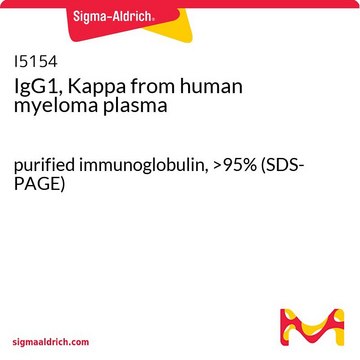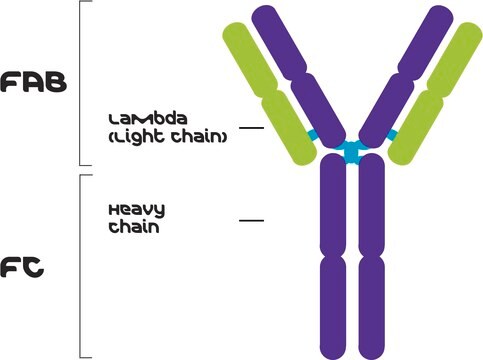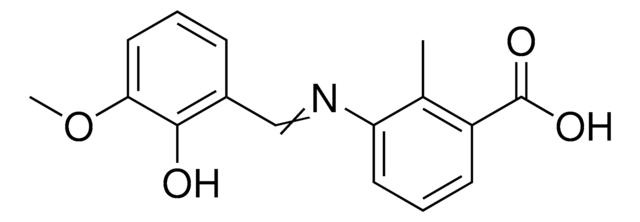Wszystkie zdjęcia(1)
Kluczowe dokumenty
I3784
IgG3, Kappa from murine myeloma
clone DX, purified immunoglobulin, buffered aqueous solution
Synonim(y):
Mouse IgG3-κ
Zaloguj sięWyświetlanie cen organizacyjnych i kontraktowych
About This Item
Polecane produkty
pochodzenie biologiczne
mouse
Poziom jakości
białko sprzężone
unconjugated
forma przeciwciała
purified immunoglobulin
klon
DX, monoclonal
Próba
≥95% (microfluidic capillary gel electrophoresis)
Formularz
buffered aqueous solution
Warunki transportu
dry ice
temp. przechowywania
−20°C
Szukasz podobnych produktów? Odwiedź Przewodnik dotyczący porównywania produktów
Opis ogólny
Podtyp przeciwciał IgG to najobficiej występujące w surowicy immunoglobuliny układu odpornościowego. Jest on wydzielany przez komórki B i znajduje się we krwi oraz płynach pozakomórkowych, zapewniając ochronę przed infekcjami wywołanymi przez bakterie, grzyby i wirusy. Matczyne IgG jest przekazywane płodowi przez łożysko, co ma kluczowe znaczenie dla obrony immunologicznej noworodka przed infekcjami. IgG3 ma unikalny wydłużony region zawiasowy nadający większą elastyczność
IgG3, κ ze szpiczaka mysiego specyficznie rozpoznaje mysie IgG3. Specyficzność mysiej IgG3, κ jest określana za pomocą technik immunodyfuzji i IEP. Oczyszczony preparat szpiczaka nie reaguje z surowicami odpornościowymi przeciwko mysim IgA, IgM, IgD, IgG1, IgG2a i IgG2b.
IgG3, κ ze szpiczaka mysiego specyficznie rozpoznaje mysie IgG3. Specyficzność mysiej IgG3, κ jest określana za pomocą technik immunodyfuzji i IEP. Oczyszczony preparat szpiczaka nie reaguje z surowicami odpornościowymi przeciwko mysim IgA, IgM, IgD, IgG1, IgG2a i IgG2b.
Zastosowanie
IgG3, κ ze szpiczaka mysiego została użyta jako czynnik blokujący w znakowaniu immunofluorescencyjnym larwalnych i dorosłych robaków Echinococcus multilocularis. Zastosowano go jako kontrolę negatywną w teście do badania wiązania powierzchniowego przeciwciał z meningokokami.
Postać fizyczna
Solution in Tris buffered saline, pH 7.2, containing 0.1% sodium azide.
Oświadczenie o zrzeczeniu się odpowiedzialności
O ile nie określono inaczej w naszym katalogu lub innej dokumentacji firmy dołączonej do produktu(-ów), nasze produkty są przeznaczone wyłącznie do użytku badawczego i nie mogą być wykorzystywane do żadnych innych celów, w tym między innymi do nieautoryzowanych zastosowań komercyjnych, zastosowań diagnostycznych in vitro, zastosowań terapeutycznych ex vivo lub in vivo lub jakiegokolwiek rodzaju konsumpcji lub zastosowania u ludzi lub zwierząt.
Ta strona może zawierać tekst przetłumaczony maszynowo.
Hasło ostrzegawcze
Warning
Zwroty wskazujące rodzaj zagrożenia
Zwroty wskazujące środki ostrożności
Klasyfikacja zagrożeń
Eye Irrit. 2 - Skin Irrit. 2
Kod klasy składowania
10 - Combustible liquids
Klasa zagrożenia wodnego (WGK)
WGK 2
Temperatura zapłonu (°F)
Not applicable
Temperatura zapłonu (°C)
Not applicable
Wybierz jedną z najnowszych wersji:
Masz już ten produkt?
Dokumenty związane z niedawno zakupionymi produktami zostały zamieszczone w Bibliotece dokumentów.
Chi-An Hsu et al.
Proteomics, 8(10), 2115-2125 (2008-05-21)
Many potential vaccine candidates for serogroup B Neisseria meningitidis (NMB) have been identified by reverse vaccinology, a genome-based approach. However, some candidates may be unseen owing to uncertain annotation or their peculiar properties. In this study, we describe the preparation
Andreas J Hülsmeier et al.
Glycobiology, 20(1), 127-135 (2009-10-14)
A major surface constituent of Echinococcus multilocularis adult worms, referred to as an EmA9 antigen, was immunoaffinity purified and identified as a high-molecular-weight glycoconjugate. Labeling studies using the monoclonal antibody MAbEmA9 indicated that this antigen undergoes a regulated expression during
Philip Roelandt et al.
Nature protocols, 5(7), 1324-1336 (2010-07-03)
Differentiation of stem cells to hepatocytes has industrial applications, as well as the potential to develop new therapeutic strategies for liver disease. The protocol described here, sequentially using cytokines that are known to have a role in liver embryonic development
Masayuki Hirano et al.
Nature immunology, 8(7), 762-771 (2007-06-15)
Because functional analysis of Fc receptors (FcRs) relies heavily on mouse models, the identification of another Fcgamma receptor is particularly noteworthy. We demonstrate that FcgammaRIV, identified here as the mouse ortholog of primate FcgammaRIII, required association of the FcR gamma-chain
S Hashira et al.
Pediatrics international : official journal of the Japan Pediatric Society, 42(4), 337-342 (2000-09-15)
Maternal immunoglobulin G (IgG), transferred across the placenta to the fetus during intrauterine life, is an important component of the neonatal immunological defence mechanisms against infection. There is controversy with respect to differences in placental transfer of the different IgG
Nasz zespół naukowców ma doświadczenie we wszystkich obszarach badań, w tym w naukach przyrodniczych, materiałoznawstwie, syntezie chemicznej, chromatografii, analityce i wielu innych dziedzinach.
Skontaktuj się z zespołem ds. pomocy technicznej









